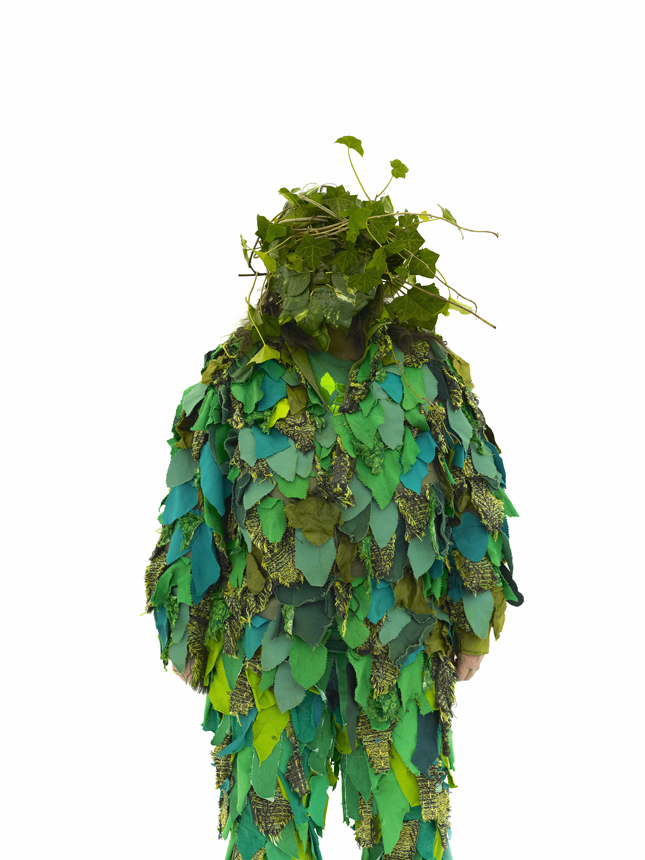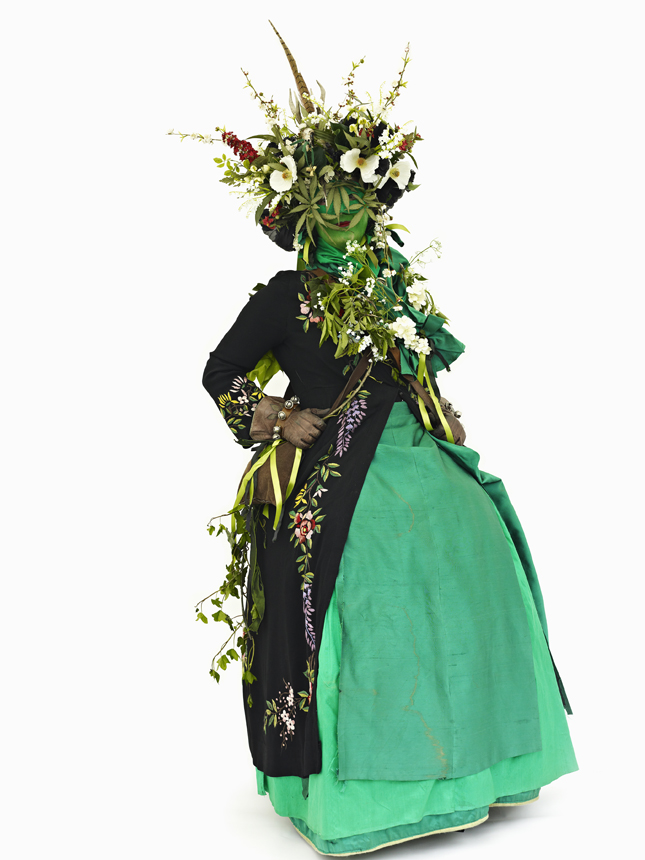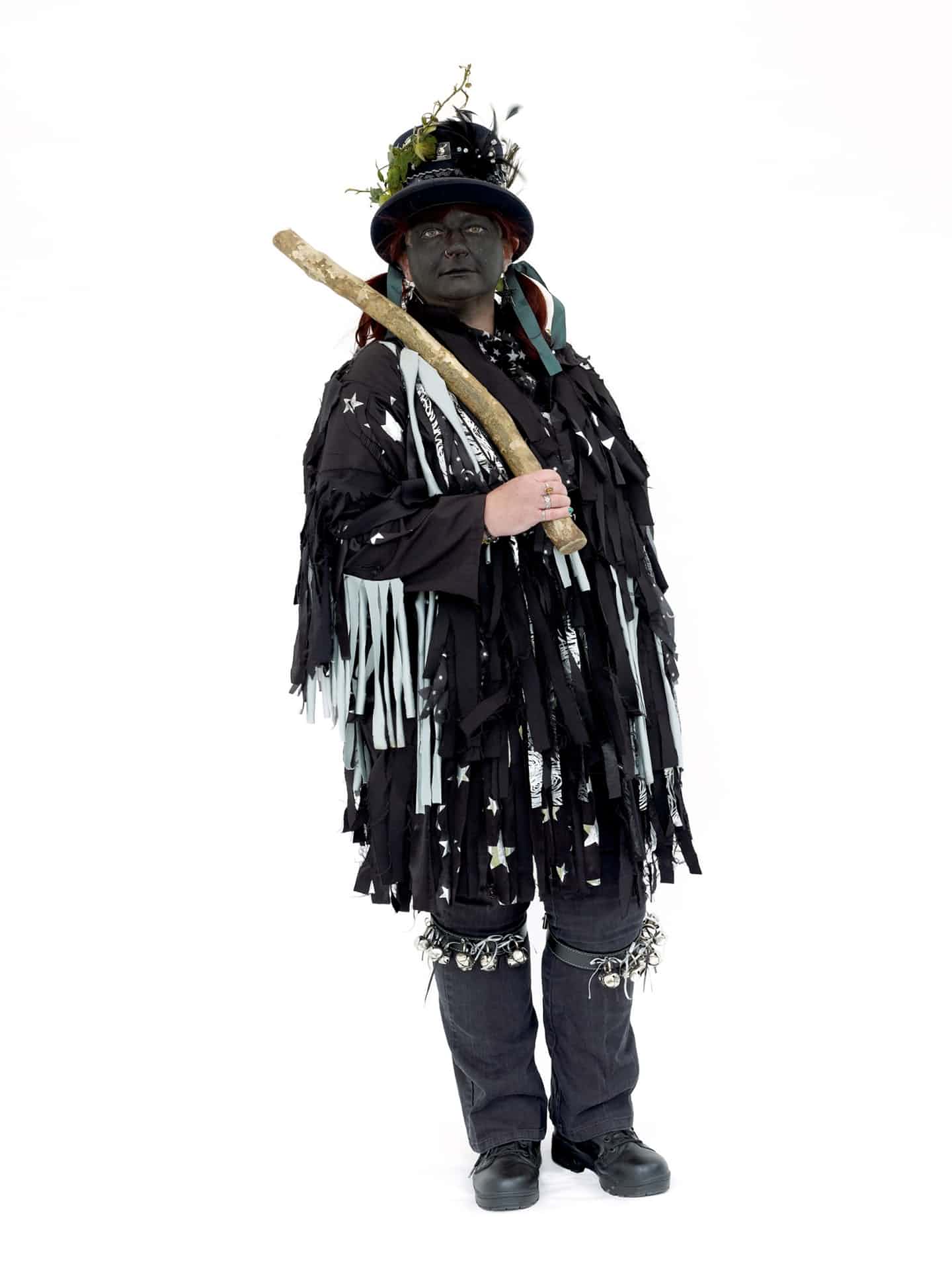
GREAT BRITAIN IS STILL a haven of magic. It is resting in the forests as well as in the suburbs, in the inner city centres and in village squares. You may not know it, but the man reading the paper over there next to you on the tube could very well be a druid, that woman in front of you in the queue at the bank a Wicca witch. British folklore has a long and momentous history and the worlds of the Abbots Bromley Horndancers, The Burryman of Queensferry, Greenmen, Morris dancers, Pearly Kings and Queens, Witches, Druids, Punch and Judy, Street Sweeping processions, Straw Bears, Hoodening Horses and Bonfire Societies are as full of mystery and enchantment as they are of joy and community. Simon Costin, distinguished artistic director, set designer and moreover also the director of the Museum of British Folklore, has been taking his small museum around ye olde Albion in an ornately decorated caravan, both documenting and partaking in this fascinating world of fantastical tales and peculiar characters. Here he helps us figure a couple of things out about what magical practitioners wear.
When you’re about to partake in an event or festival/ritual, what steps do you take to shake off your ‘everyday persona’ in order to become your ‘special’ one?
Martibogie (Jack in the Green Bogie): For me this begins with the anticipation and planning of the ritual – basically pre-empting the mind-set and purpose of the ritual. I don’t particularly place any heavy emphasis on what I’m wearing. I don’t believe that within traditional craft the adoption of specific ritual dress was necessary, although I imagine people would have worn something practical. Instead the moment I start assembling objects and working tools; setting up the altar, I start to ‘become’ magical.
Mol (Jack in the Green Bogie): It’s a question of volume; my ‘everyday persona’ is my ‘special’ one. That is, I try to live my life in a ‘holistic’ manner, but tone it down for most ‘everyday’ situations.
Raven (High Priestess of the Craft): I believe it is important to shake off the ‘everyday persona.’ In circle we are standing between the worlds so there is no place for everyday concerns. These would detract from the purpose and intent of the ritual. For me it is stilling the mind, usually through meditation. It doesn’t have to be long, it’s about switching focus.
Piri (High Priestess of the Craft): Very few, other than having a shower and getting changed, in the same way that I prepare to visit a friend.
Silver Eagle Spirit (High Priest of the Craft): I prepare by turning my mind into an altered state with the use of meditation or mantra and then into the energy we are going to use, according to the type of ritual. The use of robes helps one alter one’s mood.
Ray Lindfield (High Priest of the Craft): Writing the ritual is the art, then preparing everything needed for the ritual. This can include making incense, making cakes, deciding which equipment to use (i.e. indoors or outside) and making sure everything is clean and in good order. We also have robes and certain jewellery that we keep for ritual occasions. Just prior to starting a ritual we usually have time for a guided meditation/pathworking or a time of stillness to prepare our minds.
Simon Costin (Magical Practitioner): It all depends on the event and as to whether it is a public or private affair. If a public one, such as Jack in the Green, there is usually a weekend of build-up which includes dancing at the céilí, the gathering of leaves for the headdress and finally getting dressed into the costume on the morning of the event. All these things help to put you in a different mindset. If the event is a private ritual, a lot depends on where the ritual is taking place. If at home, I often have a bath and take a moment to sit quietly to concentrate on the task to be performed. If outdoors, the act of changing into robes always helps to get me in the right frame of mind.
Do you ever begin the ritual or event with any form of cleansing, be it drinking, eating or anything else?
Mar: In my own practice I place more emphasis on the physical act of cleansing the circle through sweeping or ‘smudging,’ rather than using salt to purify in the more ceremonial way. These are symbolic acts, which focus and dramatise the intention of purification, speaking directly to the subconscious mind through symbolic language.
Mol: Usually it’s a ten-second mind exercise, once a year it’s seventeen communal hip flasks. Just occasionally my mind refuses to play and I fail to get ‘into the swing.’
Rav: Before a ritual I take a bath to which some salt has been added. This is not the only cleansing that takes place. Before our circle is cast, the area is cleansed by the High Priestess. First by sweeping with a besom widdershins (anti-clockwise) to remove negativity. The bristles do not touch the ground. The negative energy is then cast out of the area to the east. Next, everyone attending is admitted and the four elements of earth, air, fire and water are blessed and consecrated. These are represented by salt, incense, a candle and a bowl of water. The ritual space and all those within are then cleansed and purified with each of the elements. It is only after this that the circle is cast.
Piri: I usually add clary sage oil to my water.
SES: With a ritual bath with herbs for the type of energy we are going to rise. We sometimes fast with no food for up to forty-eight hours or twelwe hours, more or less; once again it is entirely dependent on the type of ritual we are doing at the time.
RL: Cleansing often means a shower or bath just before the ritual, especially if it involves an initiation or elevation to a higher level. We often sweep the Circle at the opening of the ritual. The process of creating a sacred space involves the use of consecrated salt and water, sprinkled around the circle and over everyone in the circle which we believe is part of the cleansing process, together with incense which is wafted over everyone and a candle to represent fire, another purifying element.
SC: Again it depends on the event. If a daytime public one, such as Jack in the Green, most of the day revolves around stopping at pubs along the processional route. If a private ritual, I rarely eat or drink before as it helps to do that afterwards as a form of grounding.

How do the clothes and other accoutrements help to get you into an altered mindset?
Mar: The ambiance of the magic circle and the resulting mindset can be created through incense, music and various objects and ritual tools, much more so for me than what I’m wearing. For me certain objects that I find inspiring and magical play a big part in creating the atmosphere in the circle. It is this atmosphere that helps alter my mindset.
Mol: When doing Jack in the Green things, the smell of the body makeup (Kryolan) enforces my ‘Green Man’ persona.
Rav: Ritual clothing and other accoutrements do help to get into an altered mindset. The clothing we wear is usually a robe and it’s only worn in ritual. This also helps to put on the ‘magical persona’ needed to work between the worlds. It takes us out of the everyday world with all that world’s associations. However, the robe is not the only adornment we use. There is also jewellery worn only in circle such as a circlet or head-dress, a necklace and bracelet. Never a watch because we are outside time so it has no place in circle.
Piri: I use dress and colour according to the wheel of the year, or according to what feels right. After all, even in everyday life I wouldn’t feel right wearing a Christmas outfit and mistletoe earrings in the summer.
SES: The robes which we use are just for ritual. Normally we use the same robes all the time. It puts us in the right frame of mind. The tools that we use in the ritual help us to focus and to cut astral energy, for example with the athame, which is a ritual knife.
RL: A change of clothes is important, especially into robes. Incense is also a very powerful agent to trigger an altered consciousness as the sense of smell has a deep and dire link to a primal part of the brain.
SC: Masks can help greatly to alter your persona within a magical/ritual context and are a fascinating tool to use. Personally, I find that the objects used within a ritual help far more to produce any kind of altered mindset than the clothes do.
What importance do the clothes play in the rituals or events?
Mar: I work skyclad indoors, and wear something that fulfils the purpose of feeling comfortable outdoors. Usually I wear something black because it minimizes my attention towards what I’m wearing.
Mol: Public perception is altered, and I can get away with lots more!
Rav: Because the robe is loose it allows greater freedom of movement than tighter garments would. Since it is only worn in ritual it contains our own energy and it is energy we raise in circle for whatever the purpose of the ritual is. If we are celebrating a Sabbatt such as Lammas (grain harvest) we might act out a piece of mythology. The clothing is chosen appropriate to the role a person is playing. The colours used will often be chosen for their symbolic meaning. Again this will not be everyday clothing. This helps to get into the part in the same way an actor does.
Piri: It’s simple – they just help you to focus on what you are about to do. However, personally, I don’t think they play any significant importance. It is the intent that matters.
SES: None at all, except in a place where you cannot be without them, i.e. being covered up in public.
RL: The clothes only have specific importance if they are reserved for ritual or designed for a specific ritual, to aid taking on an alternative identity.
SC: Within the context of a public event, the clothes help to endow the wearer with a greater sense of themselves. You find yourself behaving differently when wearing a costume and you are often less inhibited. The costume helps to give you a new persona to project yourself from. With a ritual, a simple black robe does the opposite and is often worn as a form of anonymity. I find elaborate robes project ego and when working in a ritual context the will needs to be focused on the job in hand.
Have you ever been naked or skyclad for a ritual and how does it differ from being clothed?
Mar: Many times, but this is entirely dependent on how warm it is. I usually feel more distracted by my body when I’m naked than I do if I’m dressed. I do not subscribe to the belief that energy is impinged through the wearing of clothes when working magic. However if it is comfortable for me to wear nothing then that is fine. I do not believe I feel hugely different whether dressed or undressed.
Mol: Yes, and it’s colder. I usually prefer clothed, being a creature of comfort.
Rav: Skyclad, or ritual nudity, is so often misunderstood. It is not about a sex orgy. I have been skyclad in rituals. I feel it differs from being clothed in that the energy raised is direct from the body and not hampered by robes. For me there is another aspect to being skyclad. To quote from Doreen Valiente’s Charge of the Goddess, ‘And ye shall be free from slavery; and as a sign that ye be really free, ye shall be naked in your rites.’ I have certainly experienced this freedom. To be in a ritual where nobody is wearing any clothes is both freeing and validating. Nobody judges what you look like, whether young, old, fat or thin. Nobody particularly notices. This has been my experience. For me it also has to do with bonding because you are all there together, exactly as you are. As children of the Goddess and God, we are all connected.
Piri: From a personal point of view I think it is more ‘magical’ to be skyclad. It gives a greater feeling of belonging to a like-minded group of people that you trust implicitly.
SES: Yes many times. Rituals done skyclad are mostly in temples or private woods or groves. Being skyclad allows the energy from the body to be released in an easier manner, and for energy to be taken into the body.
RL: Yes, and it is different, it induces a sense of freedom. You don’t have to worry about catching robes on candles! It’s not for the self-conscious though, if you’re more worried about how you look you will not give the ritual your full attention. Whether skyclad or robed, it’s about freeing the mind from the everyday and what works best for you.
SC: I have been skyclad many times but only as a solitary practitioner, both indoors and out. A lot depends on the weather to be honest. It can be nice both at home and outside with a roaring fire going. Although quite liberating the first few times, in the end being skyclad is not essential for me – I would rather feel comfortable and able to concentrate.
How do you return to your everyday selves after a magical ritual or event?
Mar: This is a shift in thought for me, usually dramatised by the striking of a bell. This represents the end of a ritual and the circle being dissolved.
Mol: Normally through sleeping, as I like to be there till the bitter end. Sometimes a good long shower, but then I feel cheated if I have missed something. I am not a very ‘clothes conscious’ person, as you have probably observed, so I am probably less ‘altered’ than most performers.
Rav: When the ritual has ended we ground ourselves. This may be done through meditation and placing our hands on the earth to discharge any excess energy. The circle is opened, everything is packed away and the robes are exchanged for everyday clothing. We often go to the pub and socialise and in this way come back to our everyday selves.

Piri: Once you have shared something to eat and drink and the circle has closed, it is the natural progression of things to return – it just happens.
SES: Eat and drink cake and wine. Close down the seven main chakra’s, (except the Crown and Base which are already partly closed). Then ground any excess energy.
RL: Towards the end of a ritual we usually share cakes and wine and eating is the quickest way to ‘ground’ yourself. We also use an ‘earthing out’ gesture and literally touch the ground, whilst visualising all unused energies sinking into the ground.
SC: If a public event, there’s usually a chance to calm down in a pub and a discussion as to how the day went. Then finally taking a bath and scrubbing off any make-up completes the act. With a ritual there’s usually a period of closing down the area or circle used and giving time for the energy raised to dissipate having been directed. Food and drink help to complete the grounding.
Simon Costin is an artist, set designer and the founder of the Museum of British Folklore. In 2013, he became director of the Museum of Witchcraft and Magic in Cornwall.
Henry Bourne is a British photographer. His book portraying participants in this country’s folk festivals, Arcadia Britannica: A Modern British Folklore, was published in 2015.
This article was originally published in Vestoj: On Magic.